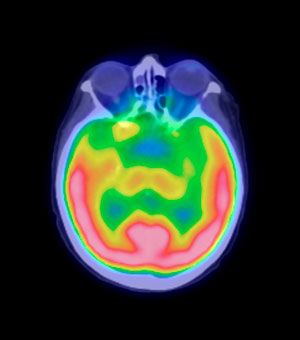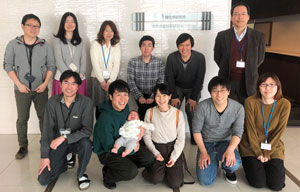Aug. 30, 2019 Research Highlight Chemistry
Doubling down on boron to make complex organic molecules
A newly discovered reaction delivers dual boron functionality to produce molecules with many potential applications
 Figure 1: Positron emission tomography (PET) shows the accumulation of molecules that have a positron emission nuclide. RIKEN researchers have found a new method to introduce two boron atoms to improve the utility of PET. © CENTRE JEAN PERRIN, ISM/SCIENCE PHOTO LIBRARY
Figure 1: Positron emission tomography (PET) shows the accumulation of molecules that have a positron emission nuclide. RIKEN researchers have found a new method to introduce two boron atoms to improve the utility of PET. © CENTRE JEAN PERRIN, ISM/SCIENCE PHOTO LIBRARY
A user-friendly method to form sought-after diborylalkenes by attaching boron groups to organic molecules has been developed by an all-RIKEN team1. Diborylalkenes are stepping stones to many valuable compounds, including pharmaceutical drugs and medical imaging probes.
The diborylation reaction was an unexpected discovery, says Takamitsu Hosoya of the RIKEN Center for Biosystems Dynamics Research. His team had recently developed a method to convert carbon–sulfur bonds into carbon–boron bonds, using a rhodium catalyst. When sulfur was attached to a carbon aromatic ring, the borylation reaction proceeded as expected. The surprise came when the team tried the reaction on sulfur attached to an alkene. They obtained a diborylated product, rather than the expected monoborylated compound.
“Our first motivation for performing this work was wanting to know why the diborylated product was obtained,” Hosoya says. “We found that a by-product of the reaction, pinacol borane, promotes both borylation steps.”
The team observed that the reaction proceeded very slowly for the first 45 minutes, with only a little of the monoborylated compound formed. The reaction then accelerated remarkably. A further 45 minutes later, the diborylated compound had formed in high yield. The gradual build-up of pinacol borane in the reaction mixture appeared to generate the active catalyst species in situ, which then dramatically accelerated the reaction.
 Takamitsu Hosoya (far right in second row) and his team have found a user-friendly method for synthesizing diborylated alkenes, which are precursors for pharmaceuticals and medical imaging probes. © 2019 RIKEN
Takamitsu Hosoya (far right in second row) and his team have found a user-friendly method for synthesizing diborylated alkenes, which are precursors for pharmaceuticals and medical imaging probes. © 2019 RIKEN
Because the sulfanyl alkenes required for the reaction can be easily synthesized from cheap chemicals such as aldehydes, and the rhodium catalyst is also commercially available, the diborylation reaction has immediate appeal, says Hosoya. “We think user friendliness is the biggest benefit of our method.”
The additional motivation for studying the reaction, Hosoya adds, is that borylated compounds can be readily turned into medical imaging probes for positron emission tomography (PET) scans (Fig. 1). PET imaging involves giving patients isotopes that emit gamma rays, such as fluorine-18 (18F), to light up areas of interest inside the body.
“One of the hurdles to PET imaging is the limited methods for introducing radioactive nuclides into molecules, which must be done at the final stage of the synthesis due to their short half-lives,” he says. “Diborylalkenes are promising precursors for synthesizing18F-labeled fluoroalkenes, via the substitution of a boron group with18F.”
Developing better methods to selectively transform diborylalkenes into18F-radiolabeled PET probes, and designing a more active catalyst to broaden the range of sulfanyl alkenes that can be converted into diborylalkenes via this method, are some of the next steps in the research, Hosoya says.
Related contents
References
- 1. Uetake, Y., Isoda, M., Niwa, T. & Hosoya, T. Synthesis of (2,2-diborylvinyl)arenes by rhodium-catalyzed desulfanylative gem-diborylation of 2-arylvinyl sulfides. Organic Letters 21, 4933–4938 (2019). doi: 10.1021/acs.orglett.9b01253
